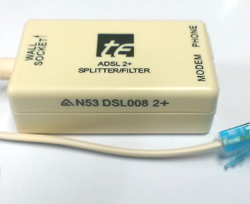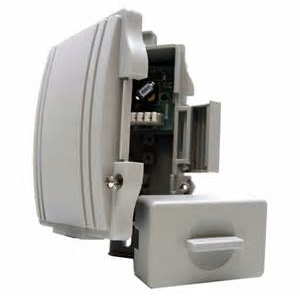NBN filters or splitters
NBN fibre to the node FTTN connections do not require filters or splitters they require the copper connection from the exchange or node to run directly to the NBN router and all internal phone cabling should be re-routed to the back of the NBN router.You can improve your Internet speed by disconnecting any unused cabling within your building and creating a direct connection from the copper network to you to your NBN router.
Everything below is no longer relevant, but it'd be a shame to see it deleted
ADSL Filters in general

The DSL Filter is often underrated but it is extremely important to the operation of your adsl service. There are two kinds of Filter, DSL and DSL2+, if you have an ADSL 2+ service you need to use a dsl2+ filter. The adsl filter is really a low pass high pass audio filter, the kind of device used in hifi stereo systems to seperate your subwoofer and tweeters from your mids. they filter out specific frequencies for the target hardware.
ADSL isn't binary information, the signal is a transmitted as audio signals, across a phone line you are talking on. in order to SPLIT the useful audio for phonecalls from the useful audio for your modem you need a SPLITTER. The right one for your service too since first generation adsl1 operated at different frequencies than adsl2+ does. modern adsl1 operates at the same frequencies as adsl2+ though you'll have no way of determining which hardware you're on.
You DO NOT NEED a filter or splitter on naked services as the only audio signals on the line are from the modem. you could install one for peace of mind...but there is no actual filtering on the modem side of most filters, only the phone side.
 Central filtering
Central filtering
There are pro's and con's to central filtering
- One splitter installed for the whole site
- Less to replace when something breaks
- The external ones have decent waterproof enclosures
The cons include
- More complicated wiring
- Outdoor enclosures do not cover holes in the wall as they sit away from the wall
- Harder to bypass if a fault occurs, usually requiring an IDC tool which in turn requires cabler registration
Central filtering can be cheaper overall as you'll only need the single splitter, but it could cost more to setup as each socket will need to be rewired. The actual filter used is largely irrelevant as the hardware inside all of a particular brands filters is the same. IE, The Telequip filters we generally use, have a Filter, Splitter, Central Splitter, External Central Spliter and Wall Mount Splitter, however each uses the same underlying circuitry in different packages.

- ADSL Filter, Used in situations that do not require a modem (these are security compatible with a second cable pair to allow unfiltered bypass of the filter)
- ADSL splitter, Used when you have both a phone and a modem. This model is the most popular by a very wide margin
- ADSL Central Splitter, This unit features both sockets and hard wired connections and a mounting plate to affix to a wall
- ADSL Wall Mount Splitter, this unit clamps onto an existing wall mount plate, allowing you to plug a modem into the side of the adapter and your existing wall mounted phone as per usual
- External Central Filter, this unit replaces your external cable entry housing and provides a water resistant seal. Cables enter from underneath through a rubber membrane and the unit sits away from the wall so if your previous install travelled through the wall instead of via conduits you will need to consider how to re-seal the wall.
All of the displayed filters are from TELEQUIP, Telequip is an OEM who supplies filters and splitters to other companies so it is not unusual to see these filters bearing different brandings.